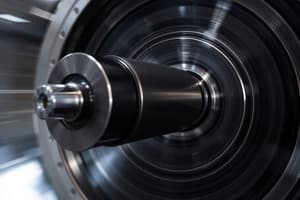Podcast
Questions and Answers
A bicycle wheel is spinning. What adjustments could be made to increase the magnitude of the torque applied to stop the wheel?
A bicycle wheel is spinning. What adjustments could be made to increase the magnitude of the torque applied to stop the wheel?
- Apply the braking force closer to the axle of the wheel.
- Increase the force applied to the brake levers. (correct)
- Apply the braking force at an angle less than 90 degrees relative to the radius.
- Decrease the coefficient of friction between the brake pads and the wheel rim.
A seesaw is perfectly balanced with two children of equal weight sitting at equal distances from the pivot. If one child moves further away from the pivot point, what must the other child do to maintain static equilibrium?
A seesaw is perfectly balanced with two children of equal weight sitting at equal distances from the pivot. If one child moves further away from the pivot point, what must the other child do to maintain static equilibrium?
- Move further away from the pivot point. (correct)
- Move closer to the pivot point.
- Jump off the seesaw immediately.
- Nothing; the seesaw will remain balanced.
A mechanic is tightening bolts on a car engine. If they double the length of the wrench, but want to achieve the same torque, how should the applied force be adjusted?
A mechanic is tightening bolts on a car engine. If they double the length of the wrench, but want to achieve the same torque, how should the applied force be adjusted?
- Keep the applied force the same.
- Quadruple the applied force.
- Double the applied force.
- Reduce the applied force by half. (correct)
A door requires a torque of 12 Nm to open smoothly. If you push on the door 0.6 meters from the hinges, what is the minimum force you must apply perpendicular to the door?
A door requires a torque of 12 Nm to open smoothly. If you push on the door 0.6 meters from the hinges, what is the minimum force you must apply perpendicular to the door?
Two forces of equal magnitude are applied to a door. The first force is applied perpendicularly at the edge of the door, and the second force is applied at the same point but at an angle of 30 degrees to the door's surface. Which force will produce the greater torque?
Two forces of equal magnitude are applied to a door. The first force is applied perpendicularly at the edge of the door, and the second force is applied at the same point but at an angle of 30 degrees to the door's surface. Which force will produce the greater torque?
A seesaw is 6 meters long and has its pivot at the center. A 40 kg child sits 1 meter from one end. Where should a 20 kg child sit to balance the seesaw?
A seesaw is 6 meters long and has its pivot at the center. A 40 kg child sits 1 meter from one end. Where should a 20 kg child sit to balance the seesaw?
A uniform beam of length $L$ and weight $W$ is hinged at one end and supported by a cable at the other end that makes an angle $\theta$ with the beam. Which of the following is necessary to calculate the tension in the cable?
A uniform beam of length $L$ and weight $W$ is hinged at one end and supported by a cable at the other end that makes an angle $\theta$ with the beam. Which of the following is necessary to calculate the tension in the cable?
A person is trying to loosen a rusted bolt. They apply a force at the end of a wrench but are unable to turn the bolt. Which of the following actions would MOST likely help them loosen the bolt?
A person is trying to loosen a rusted bolt. They apply a force at the end of a wrench but are unable to turn the bolt. Which of the following actions would MOST likely help them loosen the bolt?
Flashcards
Torque
Torque
A measure of how effectively a force causes an object to rotate around a point.
Lever Arm
Lever Arm
The perpendicular distance from the axis of rotation to the line of action of the force.
Force Angle
Force Angle
The orientation of the applied force relative to the object.
Static Equilibrium
Static Equilibrium
Signup and view all the flashcards
Force Diagrams
Force Diagrams
Signup and view all the flashcards
Torque Diagrams
Torque Diagrams
Signup and view all the flashcards
Torque and Distance
Torque and Distance
Signup and view all the flashcards
Torque and Force
Torque and Force
Signup and view all the flashcards
Study Notes
- Torque is how effectively a force causes an object to rotate around a pivot or axis.
- A pivot point is also known as a fulcrum.
- Torque depends on the:
- Amount of force applied
- Distance from the pivot point, also known as the lever arm
- Orientation of the force
Distance Affecting Torque
- Opening a door is an example of rotation.
- Door handles are on the opposite side of the hinge to maximize torque.
Third Factor
- Applying force to a tire toward the axle along the radius will not cause rotation.
- Applying persistent force tangent to the radius leads to continuous rotation.
- The orientation of the force matters.
Magnitude Ranking
- The figure shows an overhead view of a meter stick that can pivot at the position at 20 cm.
- All five forces on the stick have the same magnitude.
- The forces are ranked according to the magnitude of the torque that they produce, greatest being first.
Torque Example 1
- Pushing on a door to open it with a force of 50 N perpendicularly (at a 90° angle) 0.8 meters from the hinge produced torque.
- The torque produced is 40 Nm.
- To push with a smaller force but still have the same torque, the distance must increase.
Torque Example 2
- A mechanic uses a 0.3-meter-long wrench to loosen a bolt.
- She applies a 60 N force at an angle of 50° to the wrench, producing torque.
Static Equilibrium
- An object with forces acting on it but at rest is in static equilibrium.
- In static equilibrium, the net force is zero and the net torque is zero, meaning it is not accelerating linearly or rotationally.
Force Diagrams vs Torque Diagrams
- Force diagrams show how forces are oriented and all acting on the center of mass.
- Torque diagrams show how the force is oriented and the distance away from the pivot point.
Lab Activity Example
- A meterstick has a mass of 0.085kg
- A mass of 0.1 kg hung at .3m from 0
- A mass of 0.25kg hung on the other side.
- Calculate:
- The tension needed to hold the meterstick up
- The position that the 0.25kg mass be to balance the system.
Studying That Suits You
Use AI to generate personalized quizzes and flashcards to suit your learning preferences.



